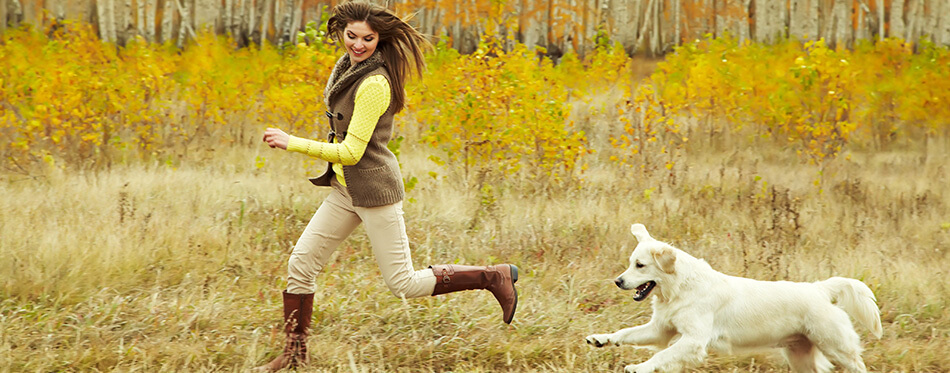We’ve all heard the phrase “followed around like a lost puppy” when talking about how some folk need to be around someone, all the time. Well, that’s a cliché for a reason! Both dogs and puppies are known for their loyal, protective traits inherent in the species – but when is affection too much? What happens in a dog’s mind, when they’re away from their owner and why do they need to be around their master so much? We answer all these questions and more, in the article, below.
What Is Velcro Dog Syndrome?
A velcro dog is a furry friend who will follow you everywhere and loathes to leave you be. Whether they’re lap dogs who just want to sit by your side all day long or a working breed who appears to constantly be under your feet as you try to go about your day. These pups will never be far from your side, wherever you go – which can get a little stressful, if wherever you are happens to be the bathroom or while handling hot pans. Worse still, if you work away from home, then it’s likely you might come back ruined furniture if your velcro dog is suffering from separation anxiety.

What Is Separation Anxiety?
Separation anxiety can occur in all kinds of dog breeds, although a velcro dog is much more likely to suffer from it than clingy dogs. It is the term used when your pet gets particularly anxious when you’re not around, causing them to behave in a destructive manner or show signs of unusual and stressful behavior. Many dogs aren’t destructive, but still suffer from separation anxiety, and these can be much harder for owners to register unless they see some of the more obvious signs.
Signs of Separation Anxiety
A dog who suffers with separation anxiety will show a wide range of different behavior, depending on how stressed they become when left alone, or with a stranger. One of the most obvious signs of this is returning home to discover that your furniture has been ruined or your room is a mess, due to separation anxiety panic. When this happens, a dog will often chew on furniture or possibly damage your doors in their attempt to be near you again or simply as a coping mechanism.
Other signs and symptoms of separation anxiety include:
- Vocalization, including howling and barking when you’re not around.
- Unusual toileting behaviors, such as peeing on the carpet, despite being house trained
- Whining and pacing
- Vomiting and self-harm (in extreme cases).
Do be aware, however, that these can also be signs of physical problems, too. If you’re worried that your dog is exhibiting these behaviors, despite being near you wherever you go, it could be that a call to the vet is in order.
However, not every clingy dog with Velcro dog syndrome will suffer separation anxiety – some simply want to be close to you, so that they can follow your lead and showcase their loyalty.
Why Is My Dog So Attached To Me?
Dogs Are Naturally Social Animals
Most clingy dogs like to be beside their owner as they are naturally pack animals. Because of this, they’re prone to wanting to be around their “pack” (you and your household) as much as possible, as it’s been bred into them. Indeed, a lot of clingy behavior can come down to your dog simply looking to spend more time with you – which is often the case if you’re working away from home for most of the day.
You’re The Pack Leader!
However, if you’re in a larger household and still find yourself explaining to others that your dog won’t leave your side, it could simply be that they’ve chosen you – out of everyone – to be their pack leader. This extra clingy behavior is actually just them trying to be close to you, so they can be ready to follow your next command.
Why Is My Dog So Clingy?
Boredom
If dogs don’t receive enough mental stimulation and physical exercise, it’s likely that they’ll come to you simply to find something to do. This is particularly true of clever dog breeds such as a Border Collie or Australian Shepherd, who will often be extra clingy when they’re bored. These types of working dogs are looking for a command to follow or job to do, so it’s always worth reading through our tips to find ways of providing plenty of mental and physical stimulation.
Check our post and find out how To Help Relieve Your Dog’s Boredom
Health Reasons
If you’ve noticed new clingy behavior from your pets, it is likely to be health-related. Again, when a dog becomes sick you might notice some physical changes, such as losing fur, changes in toileting habits or even trembling. However, some changes can show themselves as suddenly showing different behaviors, including becoming more clingy. If your usually-independent pets have suddenly started following you everywhere, or become a Velcro dog, it could be time to speak to a vet.
Similarly, dogs who have diagnosed issues such as a hearing impairment or loss of sight, may develop Velcro dog syndrome as a symptom of their new disability. In these cases, you may end up with a Velcro dog that is seeking comfort due to their health problems, or who is looking to stay near you as part of their natural survival instinct – as you, the pack leader, are seen as their protector.
Dog History and Background
It’s no secret that a rescue dog is likely to have had a poor upbringing and may struggle when it comes to attachment. If you’re quick to bond with your new pup (on their terms, of course), then you might find that your new pets will become lap dogs before you know it. This is especially true when you combine this factor with dog breeds that are prone to becoming Velcro dogs.
Reinforced Behaviour
If you spent a lot of time with your dog when they first came home, it’s likely that they have become inadvertently trained to become a Velcro dog through positive reinforcement. This is especially true if you are the main provider of treats and games!
Velcro Dog Breeds
Certain dog breeds are more likely than others to become a lap dog, or develop Velcro dog syndrome. In particular, a toy breed dog is generally known for wanting to be near their owners at all times and have very clingy personalities that causes them to be a bit of a needy dog. Still, if you own a toy breed or a dog who is naturally more prone to becoming a Velcro pup, but they seem a little aloof, don’t be concerned. After all, every dog is as unique as we are – and some pups are simply happier in their own company than others!
A Combination Of All Of The Above!
Naturally, each of these reasons can lead to Velcro dog syndrome, but a combination of these is more likely to lead to a very needy lap dog that refuses to leave your side. Velcro dogs that also suffer from a hearing impairment, for example, will beat out velcro syndrome as a standalone symptom. Combine this with accidental reinforcement or a house that has the dog sleep in the same bedroom as their owners, and you’ll naturally have a number of causes that lead to a clingy dog. There’s absolutely nothing wrong with that, however, as long as both the humans and the pets are happy with this situation!
Of course, there is always a limit as to what is generally down to being naturally a velcro dog and what is extra clingy. If you’re looking for ways to help your lap dog or clingy breed to feel more comfortable without suffering from separation anxiety panic or following you every time you need the bathroom, it’s worth checking out our tips to combating Velcro dog syndrome, below.

Dog Breeds That Are Naturally Velcro Dogs
Golden Retriever
Bred to be beside their owners at all times, the Golden Retriever is a loving – and lovable – pup that looks to their owners for direction and commands. The good news is that, like most working breeds, with the right training, you can help your retriever feel more comfortable in themselves and become less clingy.
Shetland Sheepdog
Soft and sweet – and highly sensitive to your body language and training – these Velcro dogs are adoring and attentive to their owners. They will have a habit of following you everywhere, as they can become easily attached to their owners, but their temperament causes them to be very unhappy if left alone for longer periods and therefore this breed of Velcro dog is best suited to a household with someone around, most of the time.
Cavalier King Charles Spaniel
The Cavalier King Charles Spaniel is a very social breed – and they are therefore unlikely to leave your side for even short periods. They are companion dogs by breed type and by personality, so you can expect these dogs to be extremely clingy. This is especially true if they are also a rescue dog, so be sure to read into the breed if you’re thinking about adopting one!
Labrador Retriever
Like other retriever breeds, the labrador retriever was also bred to work alongside their owner through long days. As such, they are unlikely to want to leave their owners’ side, since they were bred to wait on their next command – which they always expect at any moment. Luckily, these dogs are also easy to train out of Velcro syndrome, due to that very same nature.
Herding Breeds
The Australian shepherd, Border Collie, German Shepherd and many more dog breeds that have naturally herd are prone to being high in energy and high in intelligence. The combination of these factors send herding breeds to the top of any Velcro dogs list, every time. You might notice that herding breeds are also likely to keep in step with their owners, as they are forever waiting on their next command and so are likely to be easier to train, as a result of this. However, for those with a more sedated lifestyle, it’s fair to say that their high energy and requirement for mental stimulation causes these dogs to be incompatible with most working households.
Toy Breeds
Breeds such as the Chihuahua, Pomeranian or Shih Tzu are known for being velcro pups. This could be because of their smaller size, they prefer to be around the pack leader, who they see as their protector who will ensure no harm will come to them. Of course, as mentioned above, if you combine this with other factors, it can lead to a dog that keeps getting under your feet – and this can be dangerous for everyone involved, if you aren’t able to train these Velcro dogs out of their natural habits.
What To Do About An Overly Attached Dog
Mental Stimulation Your Clingy Dog
Dogs are well-known for being food-oriented animals – but the good news is that most velcro dogs are usually particularly interested in getting dog treats and other goodies from their owners. Since so many Velcro dogs are naturally attuned to being by their owner’s side through instinct, you can utilize this to provide ample training, and it’s likely your dogs will pick it up in no time.
Use step-by-step training to pique and keep the interest of your dog, or opt for training games and toys that will keep those tails wagging! Either way, it won’t be long before you’re comfortably able to leave the room for some much-needed space.
Physical Stimulation For Velcro Dogs
Most Velcro dogs are active, live-wire types that can’t wait for their walkies. Use this to your advantage and take them hiking, or play games in the yard to use up their energy. Once they’re worn out from a long day over the hills, you’ll soon find that your dog will sleep for longer and want a little time to themselves, too.
Crate Training
Crate training is a great option for a wide range of different reasons, from toilet training to helping with separation anxiety. By providing your pup with a sleeping area that is just for them, you can help them to create a safe space that ensures everyone in the house is happy. Don’t forget to place the crate somewhere in the room where your Velcro dogs can still see you, and train them to return to this area with toys and treats. They’ll soon associate their crate with feeling safe and secure – and you can get a little space for yourself, too. You may also like our article on the best dog crates.
Desensitizing Routines
If you’ve noticed that your dog becomes more withdrawn or anxious, every time they think you’re leaving, a good way to combat their anxiety is through desensitization. As creatures of habit, each time you grab your keys, leave the room or turn off the TV, your dog will assume you’re leaving them. However, if you do these tasks without actually leaving the house, it can help your dog to disassociate these movements with their anxiety. Over time, they’ll become a lot less worrisome as you go about your business. When you do actually leave the house, be sure not to overly fuss your pup as you leave or return, as this can also raise their anxiety levels.

Games You Can Play When Your Dog Follows You Everywhere
Fetch and Recall
Using games that rely on creating distance between yourself and your dog will get your dog used to being away for short periods of time – and build up their confidence that they can come back to you as and when it’s required.
Hunting/Smell-Based Games
Both herding and hunting breeds love to be given tasks – and nothing will appeal to their sensitive nose as much as a game of “find it”. Let your dog get used to the scent of a specific toy, before having them leave the room and hiding the toy somewhere. Command them to find the toy and watch as they get into hunting mode. If your dog struggles with this command at first, work through the training with an easier step – have them fetch the toy, before hiding it – instead of throwing it – around your person and use the “find” direction, combined with plenty of positive reinforcement. Your dog will soon associate you leaving the area with fun and games!
By building up your dog’s independence, you’ll not only provide yourself with more freedom to move around the house and go out with friends or for work, but you’ll be making your velcro dogs much more comfortable in their own company. If you find yourself saying to friends “I can’t come out – my dog won’t leave my side!” then try the above techniques for a more freeing, happy, relaxed life for both you and your canine companion. Just remember that, if there are any other sudden changes in behavior or your usually-docile dog suddenly wants to be clingy, it’s always worth asking for your vet’s opinion and a quick check-up.
Check out some dog toys, such as interactive dog toys, dog frisbees, dog balls, herding balls and dog ball launchers.

